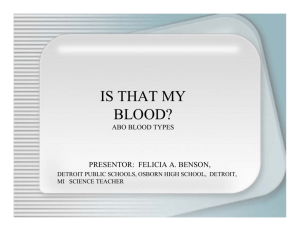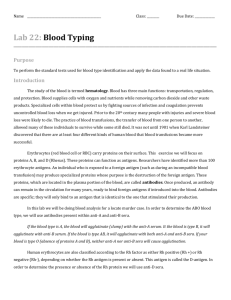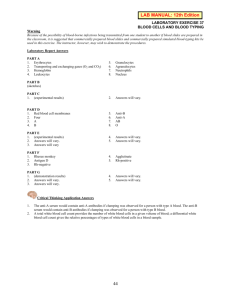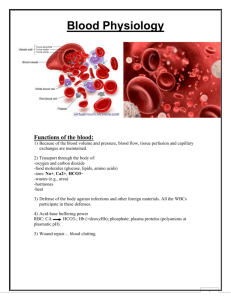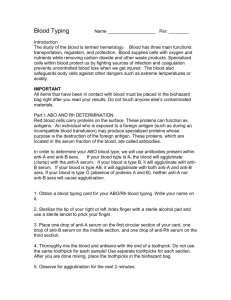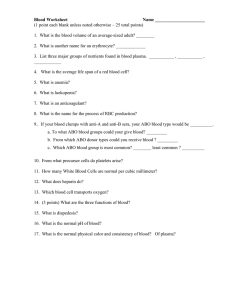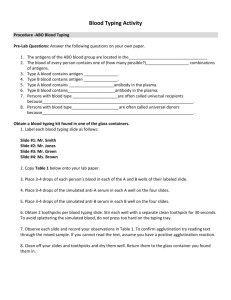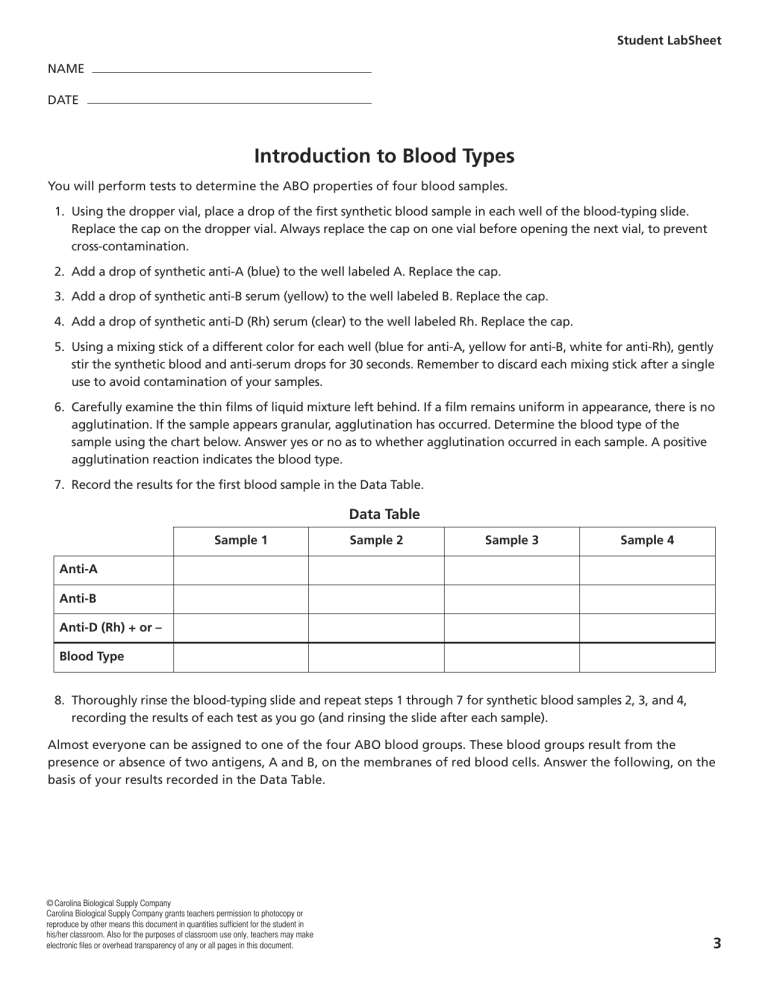
Student LabSheet NAME DATE Introduction to Blood Types You will perform tests to determine the ABO properties of four blood samples. 1. Using the dropper vial, place a drop of the first synthetic blood sample in each well of the blood-typing slide. Replace the cap on the dropper vial. Always replace the cap on one vial before opening the next vial, to prevent cross-contamination. 2. Add a drop of synthetic anti-A (blue) to the well labeled A. Replace the cap. 3. Add a drop of synthetic anti-B serum (yellow) to the well labeled B. Replace the cap. 4. Add a drop of synthetic anti-D (Rh) serum (clear) to the well labeled Rh. Replace the cap. 5. Using a mixing stick of a different color for each well (blue for anti-A, yellow for anti-B, white for anti-Rh), gently stir the synthetic blood and anti-serum drops for 30 seconds. Remember to discard each mixing stick after a single use to avoid contamination of your samples. 6. Carefully examine the thin films of liquid mixture left behind. If a film remains uniform in appearance, there is no agglutination. If the sample appears granular, agglutination has occurred. Determine the blood type of the sample using the chart below. Answer yes or no as to whether agglutination occurred in each sample. A positive agglutination reaction indicates the blood type. 7. Record the results for the first blood sample in the Data Table. Data Table Sample 1 Sample 2 Sample 3 Sample 4 Anti-A Anti-B Anti-D (Rh) + or – Blood Type 8. Thoroughly rinse the blood-typing slide and repeat steps 1 through 7 for synthetic blood samples 2, 3, and 4, recording the results of each test as you go (and rinsing the slide after each sample). Almost everyone can be assigned to one of the four ABO blood groups. These blood groups result from the presence or absence of two antigens, A and B, on the membranes of red blood cells. Answer the following, on the basis of your results recorded in the Data Table. © Carolina Biological Supply Company Carolina Biological Supply Company grants teachers permission to photocopy or reproduce by other means this document in quantities sufficient for the student in his/her classroom. Also for the purposes of classroom use only, teachers may make electronic files or overhead transparency of any or all pages in this document. 3 Mike is blood type A. When a lab technician mixes a sample of Mike’s blood with serum taken from Ken’s blood, Mike’s blood cells agglutinate. When Mike’s blood is mixed with serum from Kim’s blood, there is no agglutination. What is the most likely explanation of this? Assuming that this pattern applies to all the ABO blood groups, fill in the following chart. The ABO Blood Groups Blood Group Red Cell Antigen Serum Antibody A B AB O Rh is another human blood group. People are classified as Rh+ or Rh– depending on whether their blood cells agglutinate when mixed with anti-D (anti-Rh). Because both ABO and Rh have medical significance, both are used in designating a person’s blood type; e.g., A+, A–. About 14% of the U.S. population is Rh–. People with Rh– blood type usually do not have Rh antibody in their blood serum unless there has been a previous exposure to the Rh antigen. What are some ways that such an exposure might take place? Carolina Biological Supply Company 2700 York Road, Burlington, North Carolina 27215 Phone: 800.334.5551 • Fax: 800.222.7112 Technical Support: 800.227.1150 • www.carolina.com CB261581403
